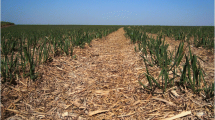Abstract
Since 1971 there has been a revival of interest in the possibilities for cultivation of the true sago palm, Metroxylon spp. Agronomic and economic research shows that the palm can become an important starch producing crop. Many queries concerning the agronomy of the crop have been solved. The palm is especially suited to humid tropical lowlands. It is fairly salinity tolerant, but less tolerant to swampy conditions than generally thought. Research programmes to solve the remaining problems have been started in Sarawak on peat soils and will be started in Indonesia on mineral soils, both regarding the cultivated crop and exploitation of natural stands. Yields of 5 tons of dry starch per ha and year in the first year, increasing to 15 tons in the tenth, are to be expected in good quality natural stands under cultivation and on mineral soils. In new plantings there will be no yield in the first eight years; after that yields will increase rapidly to 25 tons per ha and year, tapering off slowly to 15 tons. Yields on peat soils under cultivation are expected to remain 25% lower. In both natural stands and plantings an extensive drainage system is to be provided, which also allows the trunks, the raw material, to be floated out to the factory. Both systems of cultivation are expected to be economically viable with an internal rate of return estimated at 10%.
Similar content being viewed by others
References
Annual Reports of the Research Branch of the Sarawak Department of Agriculture. Government Printer, Kuching, Sarawak. (Until 1983 in the chapter Chemistry;from 1983 onwards under a separate heading: Sagopalm.)
Avé JB (1977) Sago in insular southeast Asia: historical aspects and contemporary use. In [30]: 21–30
Bahari J and Jalil MM (1986) some notes on the current status of the sago industry in peninsular Malaysia. In [7]: 72–75
Cecil JE (1986) Increasing profits from sago processing. In [7]: 112–120
Cecil JE, Lau G, Heng SH and Ku CK (1982) The sago starch industry; a technical profile based on a preliminary study made in Sarawak: pp 31. Trop. Developm. & Res. Inst. L58, Culham
Corner EJH (1966) The Natural History of Palms, 393 pp. Weidenfeld and Nicolson; London
FAO/BPPT (1986) The Development of the Sago Palm and its Products; rep. FAO/BPPT consultation, Jakarta, 16–21 January 1984: 255 pp. FAO, Rome
Flach M (1977) Yield potential of the sago palm, Metroxylon sagu, and its realisation. In [30]: 157–177
Flach M (1980) Comparative ecology of the main moisture rich starcy staples; sago palms from equatorial swamps as a competitive source of tropical starch. In [29]:110–127
Flach M (1983) The Sago Palm. FAO Plant Prod. & Prot. Paper 47: 85 pp AGPC/MISC/80. FAO Rome
Flach M (1986) Agronomy of sago-based cropping systems. In [7]: 94–101
Flach M, Cnoops FJG and Roekel-Jansen GCV van (1977) Tolerance to salinity and flooding of sago palm seedlings: preliminary investigations. In [30]: 190–195
Flach M, Braber K den, Fredrix MJJ, Monster EM and Hasselt GAM van; (1986) Temperature and relative humidity requirements of young sago palm seedlings. In [34]: 139–143
Flach M, Kraalingen DWG van and Gandrie Simbardjo (1986) Evaluation of present and potential production of natural sago palm stands. In [34]: 86–93
Flach M, Kroon AHJ and Baker JS (1971) Sago production in Pahang Tenggara. Pahang Tenggara Regional Masterplanning Study; paper 16
Hoogland JD (1986) Economics of large-scale sago exploitation. In [7]: 218–224
Holmes EB (1986) Strategy for development of fuel alcohol from sago palm in Papua New Guinea; the problems. In [34]: 166–185
Kiew R (1977) Taxonomy, ecology and biology of sago palms in Malaya and Sarawak. In [30]: 146–154
Kraalingen DWG van (1984) Some observations on sago palm growth in East Sepik District of Papua New Guinea. DME/EPU Report no 1/84 Konedobu, Papua New Guinea
Kraalingen DWG van (1986) Starch contents of sago palm trunks in relation to morphological charateristics and ecological conditions. In [7]: 105–111
Nicholson GP (1921) Le sagoutier en terrains marécageux (Malacca). Bull. Econ. Indochin 24: 159–162
Paquay LECR, Schuiling DL, Bruijn GH de, Roos RWP and Flach M (1986) Effect of nutrient shortage on young sago palm seedlings. In [34]: 144–152
Rauwerdink J (1985) Sago palms in East Sepik District in Papua New Guinea. DME/EPU Report no 1/84, Konedobu, Papua New Guinea
Rauwerdink J (1986) An essay on Metroxylon, the sago palm. Principes 30: 165–180
Riezebos EP (1986) The economics of two sago-based cropping systems. In [7]: 197–217
Sastrapradja S and Mogea JP (1977) Present uses and future development of Metroxylon sagu in Indonesia. In [30]: 122–117
Shimoda I and Power AP (1986) Investigation into development and utilization of sago palm forest in the East Sepik region, Papua New Guinea. In [34]: 94–104
Sim ES and Ahmed AM (1977) Variation of flour yields in Sarawak sago palms. In [30]: 178–180
Stanton WR and Flach M, eds. (1980) Sago; the equatorial swamp as a natural resource. Proc. 2nd int. sago symp. Kuala Lumpur, Malaysia, Sept 15–17, 1979: 244 pp. Nijhoff; The Hague
Tan K ed (1977) Sago-76. Papers 1st int. sago symp.: The equatorial swamp as a natural resource; 5–7 July 1976, Kuching, Sarawak, Malaysia: 330 pp. Kemajuan Kanji (now: Kemikro) Sdn. Bhd. Kuala Lumpur
Tan K (1986) Plantation sago in the Batu Pahat floodplain. In [34]: 65–70
Tomlinson PB (1971) Flowering in Metroxylon (the sago palm) Principes 15: 49–62
Vegter HJ, Moll OL and Holmes EB (1983) Small-scale production of starch from sago palm. EPU/DME Report no 5/83, Konedobu, Papua New Guinea
Yamada N and Kainuma K, eds (1986) Sago-'85; Tokyo, Japan; May 20–23; 3rd int. sago symp.: 23 pp. The sago palm research fund; Trop Agric Res Center, Yatabe, Tsukuba, Ibaraki, 305 Japan
Author information
Authors and Affiliations
Rights and permissions
About this article
Cite this article
Flach, M., Schuiling, D.L. Revival of an ancient starch crop: a review of the agronomy of the sago palm. Agroforest Syst 7, 259–281 (1988). https://doi.org/10.1007/BF00046972
Issue Date:
DOI: https://doi.org/10.1007/BF00046972




